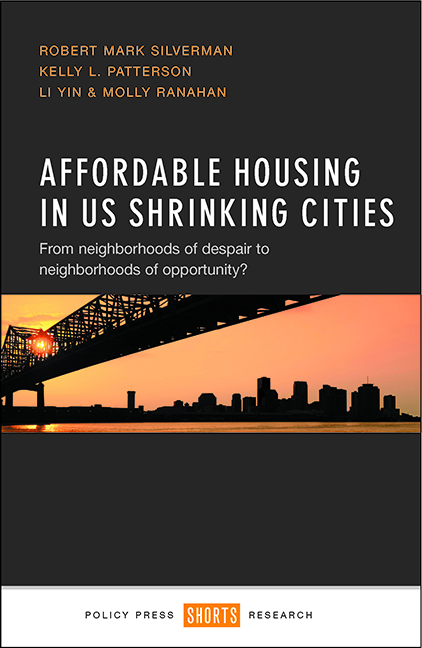 Affordable Housing in US Shrinking Cities
Affordable Housing in US Shrinking Cities Book contents
- Frontmatter
- Contents
- List of tables
- List of figures
- List of acronyms
- About the authors
- Acknowledgments
- Preface
- 1 Social equity and siting affordable housing in shrinking cities
- 2 Present-day Detroit
- 3 Present-day New Orleans
- 4 Present-day Cleveland
- 5 Present-day Pittsburgh
- 6 Present-day Buffalo, New York
- 7 Lessons learned and recommendations for siting affordable housing
- References
- Index
3 - Present-day New Orleans
Published online by Cambridge University Press: 01 September 2022
- Frontmatter
- Contents
- List of tables
- List of figures
- List of acronyms
- About the authors
- Acknowledgments
- Preface
- 1 Social equity and siting affordable housing in shrinking cities
- 2 Present-day Detroit
- 3 Present-day New Orleans
- 4 Present-day Cleveland
- 5 Present-day Pittsburgh
- 6 Present-day Buffalo, New York
- 7 Lessons learned and recommendations for siting affordable housing
- References
- Index
Summary
Introduction
This chapter examines New Orleans’ approach to urban revitalization. The chapter begins with a discussion of the city’s and region’s population decline, which began in the 1960s. This decline was rooted in structural shifts in New Orleans’ economic base and the city’s increased vulnerability to fluctuations in the global economy. The chapter traces the impacts of changes in the shipping and energy industries on the city’s trajectory. It also examines the development of the city’s convention and tourism industry in response to these changes. Although New Orleans began shrinking in the 1960s, this process accelerated after Hurricane Katrina in 2005. After the storm, the city incorporated eds and meds development into its broader recovery efforts. Consequently, one of the largest initiatives tied to hurricane recovery was the consolidation of the city’s health care system, whose infrastructure was severely damaged during the storm. The centerpiece of this anchor-based strategy was the $1.1 billion University Medical Center project.
In the context of discussing New Orleans’ decline and its urban revitalization policies, data for population and housing characteristics are presented to contextualize the city’s experience. These data reveal that, despite sustained efforts to revitalize the core city, population loss was persistent in New Orleans. It is argued that, to some degree, urban revitalization stabilized the city’s downtown, but these improvements did not have a noticeable impact on residents’ access to affordable housing and employment citywide. Moreover, residents had less access to some types of subsidized housing in revitalized areas after Hurricane Katrina. The implications of these findings are discussed in more detail in the final section of the chapter.
New Orleans in the wake of sustained shrinking
Where things stand in New Orleans
Current conditions in New Orleans are the outgrowth of decades of urban decline caused by technological and structural changes in the city’s economic base. Historically, New Orleans’ economy was dominated by two industries, shipping and energy. The shipping industry developed due to the city’s strategic location at the mouth of the Mississippi River on the Gulf of Mexico. This location made the Port of New Orleans a shipping hub from the city’s inception. However, the pre-eminence of the port declined as railroads expanded in the late 1800s and neighboring Houston expanded its rail and shipping capacity (Zaninetti and Colten 2012).
- Type
- Chapter
- Information
- Affordable Housing in US Shrinking CitiesFrom Neighborhoods of Despair to Neighborhoods of Opportunity?, pp. 47 - 70Publisher: Bristol University PressPrint publication year: 2016


